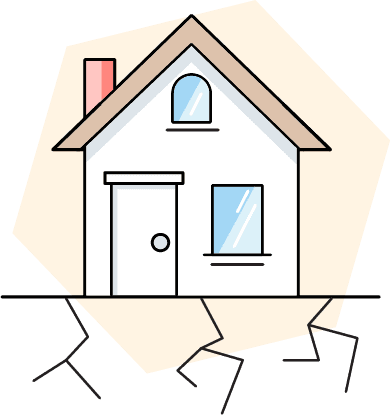High-risk home insurance covers homes that regular insurance policies may not due to an increase in perceived risk. For example, older homes with outdated electrical and plumbing systems or homes built in flood zones are often considered high-risk properties. This insurance typically covers the home’s structure and liabilities for injuries that happen on the property.
Owners or potential buyers of high-risk properties should understand their insurance options because they likely will not be eligible for standard homeowners insurance. The following guide provides an overview of the factors that lead to high-risk classification, common insurance solutions, and tips for reducing or managing property risks to potentially secure lower insurance premiums.
Table of Contents
What Makes a Home High Risk?

A home is considered high risk when an insurance company determines that it has a higher likelihood of damage or loss resulting in claims. The determination may be made based on a range of factors related to the property itself or certain characteristics of the property owner.
Home Considerations
When evaluating whether a home is high risk, insurers focus on specific aspects of the property that could increase the likelihood of damage or loss. These factors range from the physical attributes of the house to its geographical location. Some of the common characteristics that contribute to a high-risk classification include:
- Age and construction: Older homes may be viewed as high risk due to increased chances of failures and accidents, particularly if they have outdated electrical or plumbing systems.
- Location: Homes located in a high-risk area may be classified as high risk. This includes areas that are prone to floods, earthquakes, hurricanes, or wildfires. Areas with elevated crime rates also typically face higher risks, potentially leading to a high-risk classification.
- Maintenance level: Properties showing signs of poor maintenance or neglect can be flagged as high risk, as they are more susceptible to damage.
- Roof condition: The condition of the home’s roof plays a significant role. Older or damaged roofs are more vulnerable to leaks and weather impacts. It’s common for insurers to refuse to issue standard policies on homes with roofs that have reached a certain age.
- Property type: Certain types of structures, such as mobile homes or houses with unique architectural features, may have specific insurance requirements.
Homeowner Considerations
When determining risk, insurers also assess the homeowner’s profile, looking for personal factors that may increase the likelihood of a claim. This may include:
- Insurance history: A track record of multiple insurance claims can indicate a greater likelihood of future claims. Also, a history of lapsed coverage, frequent switches between insurers, or previous policy cancellations can contribute to a high-risk assessment.
- Credit score: Homeowners with lower credit scores may be perceived as higher risk due to potential financial instability.
- Home usage: Whether the home is a primary residence, a vacation home, or a rental property can impact its risk profile. Homes left unoccupied for long periods can be deemed riskier to insure because no one is around to keep it secure and watch for early signs of damage.
- Pets: Owning certain breeds of dogs or exotic pets might elevate liability concerns, especially if there is a history of aggressive or destructive behavior.
Types of High-Risk Homeowners Insurance

High-risk policies usually have unique terms and conditions, specific exclusions, higher premiums, and higher deductibles than standard home insurance. The policies may also require a more detailed application process and frequent reviews or inspections to ensure ongoing compliance with safety standards.
Whether your property has a slightly elevated risk or a significantly high risk, there are various insurance plans designed to meet your needs. Each type of high-risk homeowners insurance coverage has its own coverage scope and cost implications. The three primary options for insuring a high-risk home are standard, specialized, and FAIR plans.
Standard Insurance Plans
Standard homeowners insurance policies can sometimes be a feasible option, even for homes considered high risk. This is particularly true if the property is just slightly above the normal risk level.
A standard policy generally provides the same coverage for high-risk homes as it does for a home without a risk classification. However, it may come with higher premiums. Insurers may also adjust terms, such as requiring higher deductibles or specific exclusions.
Specialized Insurance Plans
Properties that are used as vacation homes and those that have historical significance may require a specialized insurance plan. Common options include:
- HO-1 policy: A basic form of homeowners insurance that offers limited coverage for a specific list of perils.
- HO-2 policy: A broad form of homeowners insurance that provides slightly more comprehensive coverage.
- HO-8 policy: An insurance policy specifically designed for older, historic homes. HO-8 policies typically cover a list of specific named perils rather than offering comprehensive coverage. They also protect the unique aspects of the property by covering the actual cash value of replacement costs even if they exceed the market value.
Depending on how often they’re used, vacation homes may require unoccupied home insurance, also known as a second home policy. This policy covers a list of named perils and may be more expensive than standard homeowners insurance policies due to the increased risks of vandalism, theft, or damage from a lack of regular maintenance.
FAIR Plans
Fair Access to Insurance Requirements (FAIR) plans can be an essential coverage for homeowners who struggle to obtain insurance through the standard market due to the high-risk nature of their properties. Offered in many states, FAIR plans are instituted at the state level and financially backed by private insurance companies.
Generally used as a last resort for those unable to secure coverage elsewhere, FAIR plans offer limited coverage and are intended to protect against catastrophic events. They typically offer dwelling coverage and personal liability protection and may include coverage for additional living expenses if the home becomes too dangerous to live in. Coverage for additional structures and personal property are generally not included, although some plans allow you to purchase it as an add-on.
FAIR plans are usually more expensive than traditional insurance policies. Eligibility requirements vary by state. You may also be required to submit rejection letters proving that you have already been refused by multiple standard insurers.
How Much Does High-Risk Home Insurance Cost?

For a $300,000 high-risk policy with a $1,000 deductible, you can expect to pay anywhere from $1,000 to $7,400 per year. However, the actual cost varies depending on a wide range of factors, including:
- Location: Areas prone to natural disasters or with high crime rates usually see higher premiums.
- Property condition: Older homes, especially those in need of repairs, can increase insurance costs.
- Claims history: A history of multiple claims can lead to higher premiums due to perceived increased risk.
- Home construction: Unique or non-standard construction materials may result in higher insurance costs.
- Credit score: A lower credit score may negatively impact insurance rates.
- Safety measures: Homes with security systems, smoke detectors, and other safety features may benefit from lower rates.
- Insurance provider: Each insurer may have different pricing models and risk assessments.
How to Lower Your Risk Level
If you want to save money on your insurance premiums and potentially qualify for a standard policy, you may benefit from taking steps to lower your risk level. Consider the following strategies.
Home Maintenance and Repairs
Regularly maintain and repair your home to address issues like aging roofs, outdated electrical systems, or plumbing problems. Keeping your home in good condition can significantly reduce the risk of incidents that lead to insurance claims.
- Install safety and security enhancements. Install security systems, smoke detectors, and fire extinguishers. These measures enhance safety and demonstrate to insurers that you’re actively working to prevent incidents. If you live in a high-risk area, consider installing storm shutters or reinforcing your home against natural disasters.
- Repair or replace old roofs. If your home has an old roof or roof in disrepair, it can automatically trigger a higher risk classification. Fixing the roof can positively impact your risk rating.
- Improve your credit score. Since insurers typically factor in your credit score when assessing risk, consider taking steps to improve your score. Paying bills on time and reducing debt can positively impact your insurance rates.
- Reduce how often you file claims. Avoid filing claims for minor damages that can be managed out-of-pocket. A lower frequency of claims can improve your risk profile over time.
- Spend more time at your home. If your high-risk property is not your primary residence, consider changing its usage. Homes that are regularly occupied tend to be at lower risk for issues like theft and vandalism.
All in All
High-risk homeowners insurance is essential for properties and individuals facing increased risk factors. Understanding the factors that make a home high risk and exploring coverage options can help homeowners effectively manage their insurance challenges.
In addition, implementing strategies to lower risk levels can lead to lower premiums or even making the home eligible for standard home insurance coverage.
